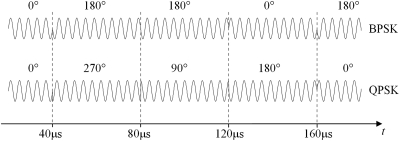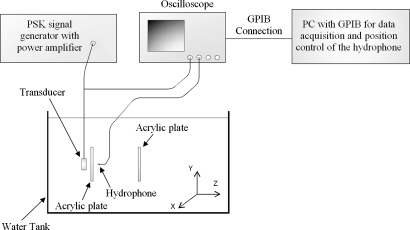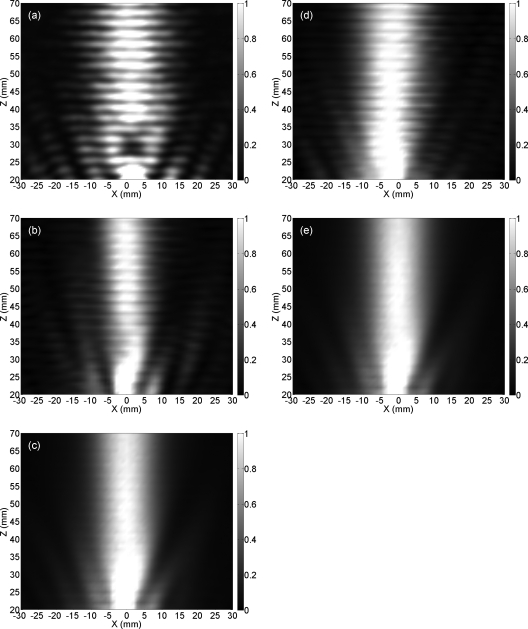Abstract
Recent papers have demonstrated that acoustic standing waves can be inhibited by frequency-modulated spread-spectrum excitation. An alternative method is studied here that is designed to be more practical for implementation in phased arrays. The method operates using phase-shift-keying (PSK), which introduces phase shifts into the driving signal to break wave symmetry. Sequential and random binary-PSK (BPSK) and quadrature-PSK (QPSK) excitations are studied in water, using a carrier frequency of 250 kHz and a time segment of 10 cycles. The resulting acoustic field is measured with a transducer inside a plastic-walled chamber and compared with continuous wave excitation. Results indicate that both the random BPSK and QPSK methods can reduce time-averaged spatial intensity variation caused by standing waves by approximately six times.
INTRODUCTION
Standing waves clearly play an important role in many applied acoustic techniques,1 however, in certain areas of acoustics, standing waves are undesirable. For example, in our laboratory’s concentration on high intensity focused ultrasound (HIFU), standing waves have been identified as a possible source of undesirable energy concentrations in transcranial ultrasound therapy.2, 3, 4, 5 Motivated by this problem, we have investigated several techniques for eliminating standing waves using practical methods.6, 7 Previous works demonstrated that time-averaged acoustic standing wave effects can be reduced by sweeping the acoustic driving frequency.8, 9, 10, 11, 12 We recently verified that this technique successfully reduces standing wave effects during transcranial ultrasound sonication and further demonstrated that random frequency modulation has superior performance in standing wave suppression than its swept-frequency counterpart.6, 7
However, the use of frequency variation introduces a number of potential problems. In therapy, narrowband transducers are generally used in order to maximize power at a given frequency. The electrical impedance of the transducer and its matching network components are also frequency-dependent, and maximum power transfer can only be achieved at a single frequency. Furthermore, phased-array beam steering uses superposition at a given frequency, so that steering a signal with continuously changing frequency would be quite complicated.
In this study, we hypothesize that standing wave symmetry can be broken by randomly changing the phase over discrete time segments while keeping the signal frequency constant. This phase-varying method, known as phase-shift-keying (PSK), was originally used in digital communication.13 To test this method for standing wave reduction, experiments are performed with four different PSK signal excitations, including sequential and random binary-PSK (BPSK) and sequential and random quadrature-PSK (QPSK). To assess efficacy, partial standing waves are set up in a water tank, and measurements using the various PSK excitations are compared. While the sequential BPSK and sequential QPSK approaches show only marginal reduction in standing waves, both random BPSK and random QPSK signals show significant reduction.
MATERIALS AND METHODS
PSK signal generation
BPSK and QPSK signals were generated with a custom-made PSK generator (Fig. 1) to demonstrate and compare the efficacy of the standing wave suppression. The carrier signal frequency was set to the transducer resonance (250 kHz). The PSK signals are described by s=Ao sin[ωt+ϕ(t)], where Ao is the signal amplitude, ω is the angular frequency, and ϕ is the phase angle shifted from the carrier signal.
Figure 1.
A block diagram of the randomized PSK signal generator.
The BPSK signal phase was switched between 0° and 180°, and the QPSK signal was shifted among 0°, 90°, 180°, and 270° from the carrier signal. The PSK signals were time-segmented over a length of 10 carrier cycles. The randomized BPSK and QPSK were achieved using a random noise generator to randomly select the phase shift of each segment. Figure 2 shows representative waveforms of the random BPSK and QPSK signals. The randomized PSK signals were filtered by a 300 kHz low-pass filter and excited the 250 kHz transducer through a radio frequency linear amplifier (240L, E&I, NY). The efficacy of standing wave suppression using random PSK excitations was compared to sequential PSK excitations, in which the segment phase shift for the BPSK and QPSK were given regular patterns of 0°, 180°, 0°, 180°,… and 0°, 90°, 180°, 270°, 0°, 90°,…, respectively. The sequential PSK signals were generated by replacing the noise generator with a binary counter.
Figure 2.
Representative random BPSK and random QPSK signals with time segment of 10 signal cycles. The phase angles are relative to the carrier signal.
Experiments
Raster scans of the acoustic field were performed for each type of excitation. Measurements took place inside a tank filled with room temperature degassed, de-ionized water (Fig. 3). A PZT transducer (250 kHz, 50 mm diameter, 10 cm radius of curvature) was driven at a voltage set to 10 Vrms. Two acrylic plates (150×90×5 mm3) were separated by 129 mm and aligned parallel to the transducer. The parallel plates are used to mimic the skull to setup the standing waves. The distance between the plate closest to the transducer and the transducer surface was 13 mm. A 2 mm diameter planar transducer (XMS-310-B, Olympus NDT, MA) was scanned by a personal computer controlled three-axis position system and its signal was recorded with an oscilloscope (TDS 3014B, Tektronix, OR). Acoustic line scans were first performed along the transducer axis of symmetry (x=0, y=0) with a step size of 0.5 mm from z=20 mm to 70 mm, where z represented the distance between the transducer faces. Two-dimensional (2D) raster scans were then performed on the x-z plane (y=0) from (x,z)=(−30,20) to (30,70) at 1 mm steps.
Figure 3.
An experimental setup for the acoustic field scan.
RESULTS
The square of the acoustic pressure was used for analysis, as it is proportional to acoustic intensity. For the specific application of thermal ablation, acoustic intensity, in turn, is proportional to absorptive temperature rise. The z-axis and the x-z plane scans of the normalized square of the pressure field are shown in Figs. 45. Figure 4 shows the line scans of the square of the acoustic pressure from excitation by the sequential and random BPSK, sequential and random QPSK, and sinusoidal CW (no PSK). Corresponding plots on the x-z plane are shown in Fig. 5. The plots in Figs. 45 are normalized to their respective average values between z=40 mm and 60 mm for comparing the standing wave suppression efficacy. Results from the line scans and the 2D plots reveal partial standing waves when sinusoidal CW (no PSK) and sequential PSK excitations were used. These standing waves are effectively diminished with the random BPSK and QPSK excitations. We quantify the standing wave contribution to the signal by a comparison of the peak, , to minimum, , over a region with the average amplitude of ,
| (1) |
This ratio (in percentage) is provided along the z-axis from z=40–60 mm in Table 1. Both the sequential modes were found to slightly reduce the standing wave effect by less than 10% in R over this distance. The random BPSK and QPSK modes suppressed the standing wave effectively, reducing the ratio from 44% to 7% and 8%, respectively.
Figure 4.
Normalized square of the acoustic field pressure along the transmitting transducer axis of symmetry with sinusoidal excitation (no PSK) and excitations with random and sequential BPSK and QPSK.
Figure 5.
Normalized square of the acoustic field pressure on the x-z plane (y=0): (a) sinusoidal CW (no PSK), (b) sequential BPSK, (c) random BPSK, (d) sequential QPSK, and (e) random QPSK.
Table 1.
Standing wave effect with different excitations quantified in terms of the R value which is defined as the comparison of the peak, , over a region with the average amplitude of as described in Eq. 1.
| Excitation | R value |
|---|---|
| No PSK | 44% |
| Sequential BPSK | 35% |
| Random BPSK | 7% |
| Sequential QPSK | 38% |
| Random QPSK | 8% |
DISCUSSION AND CONCLUSIONS
This study verified our hypothesis that randomly changing phase in time segments can break the symmetry of incident and multi-path reflected waves, thereby inhibiting standing waves. We examined and compared the performance of four potential methods for shifting phase, including sequential and random BPSK and QPSK methods. It was determined that the random PSK methods are more effective in standing wave suppression than their sequential counterparts. We also determined that the performance of BPSK is similar to that of QPSK. However, in practical system implementation, generation of BPSK is generally simpler and more cost-effective than that of QPSK, as the BPSK can be achieved by merely combining an inverter (for 180° phase-shift) and a 2-to-1 multiplexer.
Further investigation on the choice of PSK segment length still must be performed to optimize the efficacy of standing wave suppression while considering application specific operating conditions. The PSK signals used in this work are continuous waves (cws) as indicated in Fig. 2. Alternatively, phase shift in each time segment could be achieved by time delay, relative to the carrier signal. While this delay time is equivalent to a phase shift in the CW PSK signal, during this delay the transducer is not actuated, and this time period can be lengthened for the purpose of time-averaged power control.
In a previous study,7 acoustic standing waves within an ex-vivo human skull were significantly reduced using frequency randomization. With PSK excitations, only the phase of the segmented signal changes and the transducer driving frequency is kept constant. The PSK method avoids the potential problems caused by frequency-varying “spread-spectrum” techniques for standing wave suppression. Since the present study in a parallel-walled chamber represents an extreme case for standing waves, it is reasonable to suggest that the PSK method could have benefit to cw applications within the human skull. Future work will apply randomized PSK to the problem of transcranial propagation using phased arrays.
ACKNOWLEDGMENT
This work was supported by NIH Grant No. U41 RR019703.
References
- Mitri F. G., Eberlein U., and Fatemi M., “Surface roughness imaging using the acoustic emission induced by the dynamic radiation force of ultrasound,” Appl. Phys. Lett. 88, 234105 (2006). 10.1063/1.2211187 [DOI] [Google Scholar]
- Azuma T., Kawabata K., Umemura S., Ogihara M., Kubota J., Sasaki A., and Furuhata H., “Schlieren observation of therapeutic field in water surrounded by cranium radiated from 500 kHz ultrasonic sector transducer,” Proc.-IEEE Ultrason. Symp. 2, 1001–1004 (2004). [Google Scholar]
- Daffertshofer M., Gass A., Ringleb P., Sitzer M., Sliwka U., Els T., Sedlaczek O., Koroshetz W. J., and Hennerici M. G., “Transcranial low-frequency ultrasound-mediated thrombolysis in brain ischemia: Increased risk of hemorrhage with combined ultrasound and tissue plasminogen activator: Results of a phase II clinical trial,” Stroke 36, 1441–1446 (2005). 10.1161/01.STR.0000170707.86793.1a [DOI] [PubMed] [Google Scholar]
- Culp W. C. and McCowan T. C., “Ultrasound augmented thrombolysis,” Current Med. Imaging Reviews 1, 5–12 (2005). 10.2174/1573405052953074 [DOI] [Google Scholar]
- Aubry J. F. and Fink M., “Transcranial ultrasound-mediated thrombolysis: Safety issue,” in Proceedings of the 7th International Symposium on Therapeutic Ultrasound (2007).
- Tang S. C. and Clement G. T., “Approach for inhibiting standing waves in transcranial ultrasound therapy,” Proceedings of the 8th International Symposium on Therapeutic Ultrasound (2008), pp. 3–7.
- Tang S. C. and Clement G. T., “Standing wave suppression in transcranial ultrasound therapy using random-signal-modulation excitation,” 2008 Proc. IEEE Int. Ultrason. Symposium (2009), pp. 2048–2051.
- Mitria F. G. and Fatemi M., “Improved vibroacoustography imaging for nondestructive inspection of materials,” J. Appl. Phys. 98, 114901 (2005). 10.1063/1.2130515 [DOI] [Google Scholar]
- Louis B. and Long G. B., “Sonic washer,” U.S. Patent No. 2985003 (1961).
- Candy B. H., “Ultrasonic vibration generator and use of same for cleaning objects in a volume of liquid,” U.S. Patent No. 5496411 (1996).
- Mitri F. G., Greenleaf J. F., and Fatemi M., “Chirp imaging vibro-acoustography for removing the ultrasound standing wave artifact,” IEEE Trans. Med. Imaging 24, 1249–1255 (2005). 10.1109/TMI.2005.854518 [DOI] [PubMed] [Google Scholar]
- Erpelding T. N., Hollman K. W., and O’Donnell M., “Bubble-based acoustic radiation force using chirp insonation to reduce standing wave effects,” Ultrasound Med. Biol. 33, 263–269 (2007). 10.1016/j.ultrasmedbio.2006.07.039 [DOI] [PMC free article] [PubMed] [Google Scholar]
- Stremler F. G., Introduction to Communication Systems, 3rd ed. (Addison-Wesley, Reading, MA, 1990), Chap. 10, pp. 618–625. [Google Scholar]







